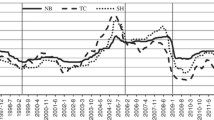Abstract
In this article we derive an equation defining contemporaneous equilibrium prices across the four shipping markets: the newbuilding market, the second-hand market, the demolition market and the freight market. The model requires rather general conditions, namely that (i) all second-hand ships are priced based on linear depreciation down to scrap value, (ii) expectations of the future scrap value and lifespan of the vessel are equal to current values and (iii) the term structure of (time charter) freight rates is observable. In the empirical part of the article we use this equilibrium relationship to illustrate the presence of a ‘term structure of newbuilding prices’ and show that the lower volatility of newbuilding prices compared with second-hand values is a result of a time-varying delivery lag, which is positively correlated with the alternative cost of operating in the freight market. These observations are important for statistical analysis of the dynamics of ship values.



Similar content being viewed by others
Notes
The two would only be identical in the case of full upfront payment to the shipyard, a rare occurrence.
References
Adland, R., Jia, H. and Strandenes, S.P. (2006) Asset bubbles in shipping? An analysis of recent history in the drybulk market. Maritime Economics and Logistics 8 (3): 223–233.
Adland, R. and Koekebakker, S. (2007) Ship valuation using cross-sectional sales data: A multivariate non-parametric approach. Maritime Economics and Logistics 9 (2): 105–118.
Beenstock, M. (1985) A theory of ship prices. Maritime Policy and Management 12 (3): 215–225.
Beenstock, M. and Vergottis, A. (1989) An econometric model of the world shipping market for dry cargo, freight and shipping. Applied Economics 21 (3): 339–356.
Dikos, G. (2004) Newbuilding prices: Demand inelastic or perfectly competitive? Maritime Economics and Logistics 6 (4): 312–321.
Dixit, A. and Pindyck, R. (1994) Investment Under Uncertainty. Princeton, NJ: Princeton University Press.
Greenwood, R. and Hanson, S. (2014) Waves in ship prices and investment. The Quarterly Journal of Economics, doi: 10.1093/qje/qju035. First published online: November 25, 2014.
Kalouptsidi, M. (2014) Time to build and fluctuations in shipping. American Economics Review 104 (2): 564–608.
Strandenes, S.P. (1984) Price Determination in the Time Charter and Second Hand Markets. Discussion Paper 05/84, Norwegian School of Economics and Business Administration: Bergen, Norway.
Strandenes, S.P. (1986) Norship: A Simulation Model of Markets in Bulk Shipping. Discussion Paper 11/86, Norwegian School of Economics and Business Administration: Bergen, Norway.
Strandenes, S.P. (2002) Economics of the markets for ships. In: C.Grammenos (ed.) Handbook of Maritime Economics and Business. London: Lloyds of London Press, pp. 186–202.
Tsolakis, S., Cridland, C. and Haralambides, H. (2003) Econometric modelling of second-hand ship prices. Maritime Economics and Logistics 5 (4): 347–377.
Zannetos, Z. (1966) The Theory of Oil Tankership Rates. Cambridge, MA: MIT Press.
Acknowledgements
The authors would like to thank the anonymous referees for their comments that contributed to improving this article as well as participants at the International Forum for Shipping, Ports and Airports (Hong Kong, 2014) for comments on an early version of the article.
Author information
Authors and Affiliations
Rights and permissions
About this article
Cite this article
Adland, R., Jia, H. Shipping market integration: The case of sticky newbuilding prices. Marit Econ Logist 17, 389–398 (2015). https://doi.org/10.1057/mel.2014.35
Published:
Issue Date:
DOI: https://doi.org/10.1057/mel.2014.35




